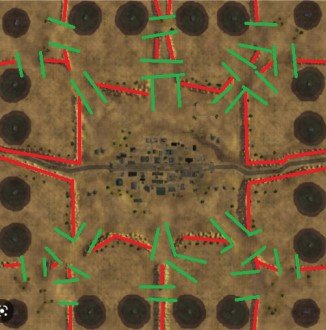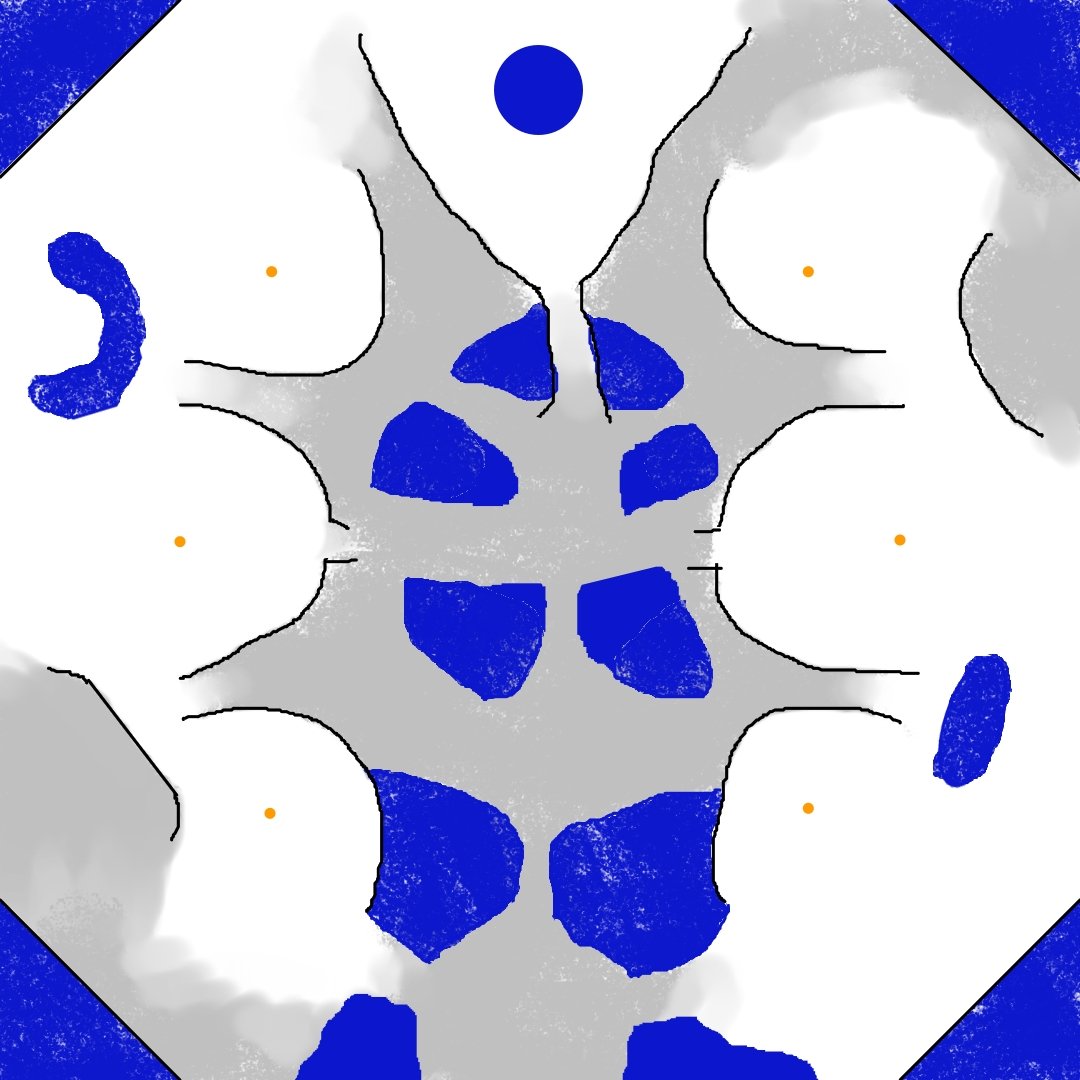My first assignment was to create a 6 player map that was massive in comparison to most other RTS games, situated in a winter environment.
Research
For this map the Creative Lead had some references he wanted me to study to create something unique. The idea was to take as many of the best concepts in those maps and adapt them for this game's unique features.
From the maps that I was given to study, I took 3 aspects to focus the map around:
Separate the players into smaller groups at the beginning of the match
Divide the map into multiple easily identifiable zones that are highly interconnected
Set the center of the map as a late game objective
Design Sketches Proposals
After I finished investigating the references, I started sketching several general layouts that used the 3 main ideas in different ways. I iterated on these ideas as much as possible until the day I presented them.
Map A: The players start separated in 3 groups of 2, each group atop one of the mountains. The center of the map is surrounded by lakes with 3 narrow roads as entrances.
This was one of the selected maps
Map C: The players start surrounded by forests. The center areas of the map can only be reached by walking across narrow bridges.
This was one of the selected maps
Map H: The players start on 2-floor structures that are easy to defend. The empty structures contain resources. To cross to the other islands the players must walk on long and narrow bridges. The most valuable resources are on the islands at the center. This is a polished version of map D with the added idea of focusing on the center from the other 4 maps.
Map B: The players start separated in 2 groups of 3, each on platforms on the corners of the map. The map is composed of several platforms of different heights connected by narrow bridges.
This was one of the selected maps
Map F: The players start separated in 3 groups of 2, each group on a platform which connect to the mountain and the valley. This is a merge between Map A and B.
Map D: The players start on 2-floor structures that are easy to defend. The empty structures contain resources. To cross to the other islands the players must walk on long and narrow bridges.
This was one of the selected maps
Using the feedback from week 1 I iterated those proposals into something more polished which I showed at the end of the second week. In this presentation the Creative Lead chose the idea he liked the most for me to start working on the details.
Map I: The players start on their own mountain. The center area has the most valuable resources and is surrounded by lakes with narrow roads as the only way in. This is a merge between Map A and C.
Map E: The players start separated in 3 groups of 2. The map is mostly open to promote aggressive and quick matches. The center of the map can only be reached by crossing narrow bridges.
The idea that was chosen was Map G. The players would start the match separated in 2 groups at the top of the mountains, each player in its own fort. This map offered a good balance of options for aggressive and defensive players, variety in areas and used the most of the large scale of the game.
Map G: The players start separated in 2 groups of 3, each group on a structure built on a mountain. The map is divided by a lake that has an island at the center with the most valuable resources. This is a merge between Map A and D.
This is the map that was selected
This process took 2 weeks, with me presenting one set of proposals at the end of each week. In the first week I presented the ideas I had for feedback, from which I was told to drop 1 of the ideas and expand and merge the other 4.
Paper Prototype Iteration
After we had defined the general design of the map I started working on its detailed version. My methodology was to divide the work in parts to make designing such a large map feasible. Also, in the same fashion as before, iterate as much as possible.
As mentioned before I divided the map design into assignments to make it approachable. One thing that made this process easier was realizing that due to the nature of PvP games, the map was highly symmetrical. Keeping this in mind I could focus on designing just one of the parts, and once it is finished mirror it.
Next I divided the map in sections, these sections accomplished two functions. The first one was allowing me to delimit and visualize the spaces players would use early, mid or late game. Second, it helped me to focus on just one section of the map at a time.
Iteration 1, spawn area and south adjacent forest
Iteration 4, symmetry to the map, polish of the south-west and north-east areas, and polish of the lakes
Beyond dividing the map into the areas I also divided it based on the level of detail. For example the early version of the map only has the large bodies of water defined. As I iterated on it, the lakes started to change and get more detailed while also I started adding the smaller rivers.
Thanks to the iterative process I identified issues to fix, like the shape of the lakes not being interesting enough or that some areas required more obstacles. One of the most impactful changes that I made as I iterated was the simplification of the forests. I knew I wanted the forest to feel real, for this reason I tried placing them in somewhat random areas to avoid roads that look unnatural. Later on I merged these small areas into larger ones, creating clear roads that helped guide the players. This not only solved my issue of readability but also maintained my premise of the map feeling real.
Iteration 2, south-west area
Iteration 5, simplified forests and polish of the south-west and north-east areas
Iteration 3, polish of previous areas, small rivers and north adjacent forest
Unity Implementation and Iterations
Once I felt confident in the map I started implementing it into the Unity project. I used the Terrain Tools Plug-In for this based on a suggestion of one of the programmers. Though I was new to using it, the plug-in was easy to learn and increased the speed of the map making process by an incredible amount. It allowed me to perform large changes rather quickly on both the geometry and the textures of the map.
Another tool that helped me a lot was the Prefab World Builder plug-in. It allowed me to place large quantities of prefabs in the map, randomizing their size, rotation and even which prefab was placed.
With these tools I managed to iterate quickly, showing progress as often as possible to the Creative Lead and other team members. Thanks to this quickly iterative process I managed to identify and solve the issues that appeared. For example, early on I discovered that most of the assets were not using the same scale, which made it really hard to keep consistency especially if we wanted to make many more maps. Because of this I spoke to the art team to fix the way we were exporting assets to have them in the correct scale. Also, I had to make the new prefabs with the correct scale and fix the ones we already had.




















